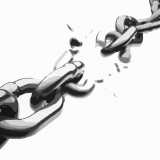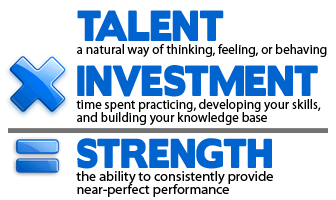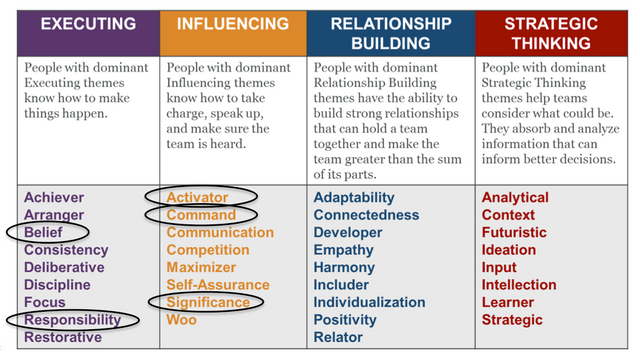Unleash Your Super-Power, Part 3: How to Live Your Strengths

This weekend, I’m meeting with about 90 property investors in Melbourne and Sydney, training them how to apply what I’ve been writing in this series, specifically to their goals in real estate.
I’m not sure whether you love the work that you do or not, but if you do, I bet it’s because every day you are able to play to your strengths. If you hate your work, most likely you’re forced to do tasks that you know you’ll never be one of the best in the world at.
5 Keys to Living Your Strengths
My hope through this series is that you’ll catch a glimpse of what your strengths could be, and be guided to position yourself so that you can live out those strengths more consistently. To that end, here are five keys to living out your strengths:
1. Look for clues already present in your life.

When I was in university, my favourite class was “Financial Markets and Money.” The lecturer graded all of the exams on a curve. The highest score in the class became an “A,” and everyone else’s test would be graded based on that standard. Of course, everyone hoped that the highest grade would be something like 75%. That way, the standard would be much lower and a grade in the 60s would be a “B.”
The entire class hated me. I consistently scored in the high 90s, which completely destroyed the curve. No one else even came close. I don’t know why I scored so high. Something about the big picture of money and finance just clicked with me.
Conversely, I never could get my head around basic accounting. I had to take the first-year business school accounting class twice. The second time around, I just barely managed to get a “C.”
So what can you see in your life, past or present, that might point to either a strength or a weakness?
What are some signs that you may have tapped into a super power?

- Rapid learning: What have you been able to pick up and excel at very quickly?
- Moments of genius: Have you ever done something and your ability was so stunning that people marveled?
- Near perfect performance: What are you so good at that you cold never stand for average?
- Passion or intense satisfaction: What have you done that made you feel most alive?
- Lose track of time: When does the rest of the world seem to disappear?
What are some signs of a weakness?

- Defensive about performance: Are there any tasks you do that you hate to be questioned about?
- Super-slow learning: Is there something that everyone else seems to grasp but you?
- Absolutely no enjoyment in repeated performance: What do you have to do that you hate to do?
- Must deliberately think through the steps: What do you need a cheat sheet for no matter how many times you do it?
- Lack of confidence in an activity: What do you have to do that you feel very substandard at?
Once you’ve made a list of what you believe to be your strengths and weaknesses, you can then apply your StrengthsFinder feedback to that list. This should help you better understand how your past performance relates to your talents, or lack thereof.
2. Turn your talents into strengths.
The top five results you get from StrengthsFinder after taking the assessment are not actually strengths, they are talents, or potential strengths. It’s your job to convert those talents into strengths.

As the above image illustrates, you must make an investment to convert your talents into strengths. You must spend time practicing and developing your skill, and building your knowledge base.
For example, one of my top StrengthsFinder talent themes is Significance. People with this talent want to be very significant in the eyes of other people. They want to be recognized and heard. They want to leave a legacy, and ensure that their life matters. They want to make a deep impact in the lives of others.
For many years, this talent laid dormant because of my insecurity. I mentioned in a previous post that I was very fearful of speaking in front of other people. But there was a part of me that earned for the spotlight.
My Significance theme pushed me to invest time and energy to develop the skill of public speaking. I took several courses on how to become a better communicator. I practiced and rehearsed over and over what I wanted to say when given the opportunity. I asked for coaching and feedback from those who heard me speak so I could get better. Gradually, I did get better.
Now I speak regularly in front of crowds of 700 or 800 people. I could have never imagined doing that twenty or even ten years ago. But my investment turned my talent into a strength.
3. Know your talent mix.
Each of the 34 StrengthsFinder themes fits into one of four different groupings or domains:
- Executing: a focus on working harder
- Influencing: a focus on leading people
- Relationship Building: a focus on working with people
- Strategic Thinking: a focus on working smarter

I’ve circled my top five most dominant StrengthsFinder talents in the image above. Here they are listed with descriptions:
- Significance: People strong in the Significance theme want to be very important in the eyes of others. They are independent and want to be recognized.
- Command: People strong in the Command theme have presence. They can take control of a situation and make decisions.
- Activator: People strong in the Activator theme can make things happen by turning thoughts into action. They are often impatient.
- Belief: People strong in the Belief theme have certain core values that are unchanging. Out of these values emerges a defined purpose for their life.
- Responsibility: People strong in the Responsibility theme take psychological ownership of what they say they will do. They are committed to stable values such as honesty and loyalty.
You can download a list of the descriptions for all 34 themes here.
As you can see, I’m heavily weighted in the Executing and Influencing domains, but have no strengths at all under Relationship Building and Strategic Thinking. That tells me that I tend primarily to live my life by working hard and influencing other people.
Based on the principles I shared in Part 2 of this series, we improve by focusing on strengths not weaknesses. Knowing this, I should seek to further develop these tendencies to work hard and influence people into full-fledged strengths.
But my talent mix also reveals some holes in my game. I’m not going to very naturally gifted at building strong relationships, nor at absorbing and analyzing information to make better decisions. This reveals some weaknesses that I need to manage around.
By circling your top five talents on the chart of the four StrengthsFinder domains, you can get a better grasp on which broad areas you tend to be strongest and weakest in. If you send me a private message on steemit.chat I can get you a copy of the above chart.
That brings us to the next point.
4. Develop a strategy to manage around your weaknesses.

A weakness is anything that gets in the way of excellent performance. There are many examples of how my lack of “working smarter” talents gets in the way excellent performance.
Just recently, I made a decision and a commitment to join a team, but soon after, I realised that I had made the wrong decision. This was an excruciatingly painful situation for me because I knew that staying in the group just out of loyalty or faithfulness to my decision would bring a lot of problems in the future. But at the same time, my Responsibility theme, which values honesty and loyalty, was making me feel really bad about the thought of breaking my commitment.
Because Responsibility is not as strong as some of my more dominant talents, I was able to override those negative emotions and walk away. But it was SO emotionally painful and all of it could have been avoided had I done my due diligence before making the decision to commit to the team. Because I lack Strategic Thinking talents, I must figure out a way to manage around this glaring weakness.
In my next post, I’ll go through some specific strategies for how to manage around weaknesses. But remember what I wrote in the last post; it’s a waste of time to try to turn weaknesses into strengths. At best, you can get a little bit better, but most likely, you’ll need another more creative strategy.
5. Use your strengths to build strong team relationships.

There are few things more rewarding in life than working with a group of people that you love to be around in fulfillment of a worthy goal. I’ve been a part of a few teams like this, and it was a very joyful experience. Besides, you can never really accomplish anything truly great on your own. You will always be more effective in partnership with like-minded people.
I’ll go more in depth on how to build strong team relationships in my fifth and final post in this series. In the mean time, I’ll just say this: knowing your strengths and that of the people that you align yourself with makes all the difference.
Several years ago, I was a part of an organization that had a leader that lacked an awareness of his strengths and weaknesses, and also those of the others on the team. People became so frustrated, not only as this leader tried to do most things himself, things that he was obviously not good at, but also as he tried to get his followers to do things that they could never be great at.
This organization was like a revolving door. The leader was charismatic and could attract people, but once they started working with him, they would get so frustrated and disillusioned that they would move on. It was very painful to watch. I finally had enough and left myself.
The best teams I’ve ever worked with were made up of a group of people that strongly valued the unique contributions that each person could bring. People were not expected to do things that they weren’t naturally talented at. Everyone had their lane and they ran in it. And everyone celebrated both the good and the bad of one another’s distinctive mental hard wiring.
Why not take the StrengthsFinder assessment yourself?

Anyone can purchase access to the 100-question StrengthsFinder assessment for only $15. It also comes with a digital copy of the book StrengthsFinder 2.0, which gives an introduction to the program and explains each of the 34 talent themes.
Here’s the link: https://www.gallupstrengthscenter.com/Purchase/en-US/Product
If you do decide to take the assessment and you’d like some feedback or have any questions, please send me a private message on steemit.chat. I’d love to connect and help you any way I can.
Follow me to catch the final two posts in this series.
As I’ve been preparing this week for the upcoming training days that I mentioned before, I decided to package some of what I’ll be saying into this series of posts to share with you. I hope you enjoy them and find them beneficial.
Here are the final two remaining posts in the series:
- Unleash Your Super-Power, Part 4: How to Deal with Weakness
- Unleash Your Super-Power, Part 5: Building Strong Team Relationships
And if you missed Parts 1 or 2, here are the links:
- Unleash Your Super-Power, Part 1: Why you MUST Discover Your Strengths
- Unleash Your Super-Power, Part 2: Where Our Strengths Come From
Recommended Reading
- First, Break All The Rules: What the World's Greatest Managers Do Differently, by Gallup Press
- Now, Discover Your Strengths, by Marcus Buckingham and Donald O. Clifton
- Go Put Your Strengths to Work: 6 Powerful Steps to Achieve Outstanding Performance, by Marcus Buckingham

Very good post @jasonstaggers. Liked your way of presentation.
Thanks @funnyman.
Another good post. I know what some of my strength are just by looking at the chart. I am interested in the "test", but not in paying $89 for it lol. Thanks for sharing the info. Peace.
Thanks @krnel. No need to pay $89. The $15 option is all you need. It's worth every bit of that.